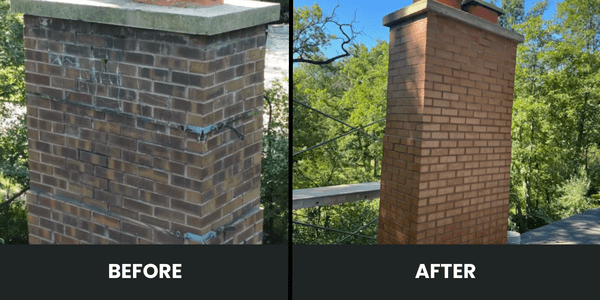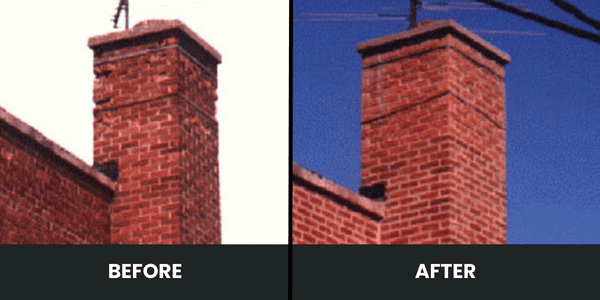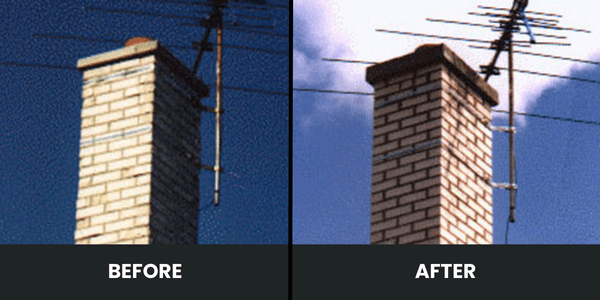Professional Chimney Repair Services
"Chimneys are usually the first part of a masonry building to manifest signs of deterioration. This is mostly due to the fact that chimneys are constantly bombarded by the elements."
Chicagoland Tuckpointing And Masonry Repair
Servicing all your masonry restoration needs while preserving your building's cosmetic appeal...
Our Services Include:
Tuckpointing
Masonry Restoration
Brick Repair
Stone Restoration
Lintel Replacement
Panel Brick Repair
Chimney Repair
Caulking
Waterproofing
Power Washing
Professional Chimney Repair Services







Expert Chimney Restoration and Rebuilding
Chimney repair fixes the structural, safety, and weatherproofing problems that develop in brick and stone chimneys over time. From tuckpointing deteriorated mortar to rebuilding unstable structures, professional chimney repair protects your home from water damage, prevents collapse hazards, and ensures safe fireplace operation.
Chimneys take more abuse than any other part of your building. They need specialized attention from masons who understand their unique challenges.
Common Chimney Problems
Deteriorated Mortar Joints
Chimney mortar fails faster than wall mortar because:
- Constant exposure to weather from all sides
- Freeze-thaw cycles attack from multiple directions
- Heat stress from inside
- No protection from roof overhangs
- Rain and snow hit chimneys directly
When mortar fails, water pours into the chimney structure.
Cracked or Spalling Bricks
Chimney bricks deteriorate from:
- Water penetration and freezing
- Heat cycling from fires
- Age and weathering
- Poor quality brick originally used
- Settlement or structural movement
Damaged bricks need replacement before they fall.
Leaning or Unstable Chimneys
Chimneys lean when:
- Foundations settle or fail
- Frost heaves shift footings
- Mortar completely breaks down
- Bricks are missing or failing
- No proper structural support
Leaning chimneys can collapse onto your roof. This is an emergency.
Chimney Crown Damage
The crown is the concrete or mortar cap at the top. It fails from:
- Cracks from weathering
- Poor original construction
- Water infiltration
- Freeze-thaw damage
Failed crowns let massive amounts of water into the chimney.
Flashing Failure
Flashing seals where the chimney meets the roof. It fails when:
- Sheet metal corrodes
- Caulking breaks down
- Improper installation
- Roof work disturbs it
Bad flashing causes interior water leaks.
Internal Deterioration
Inside the chimney:
- Flue tiles crack from heat and moisture
- Smoke chamber deteriorates
- Fireplace damper fails
- Creosote buildup creates fire hazards
- Water damage rots structural components
You can't see these problems from outside but they're serious.
Our Chimney Repair Process
1. Complete Inspection
We assess your entire chimney:
- Structural stability and plumbness
- Mortar and brick condition
- Crown condition
- Flashing integrity
- Interior flue and smoke chamber
- Foundation and footing
- Identify all problems, not just obvious ones
2. Detailed Repair Plan
You get a clear proposal for:
- All necessary repairs
- Options (repair vs. partial rebuild vs. complete rebuild)
- Detailed cost breakdown
- Timeline
- What's critical vs. what can wait
3. Repair Execution
- Grind out deteriorated mortar
- Repoint with proper mortar
- Match existing joints
- Complete coverage
- Remove damaged bricks
- Install matched replacements
- Proper mortar and bonding
- Structural integrity restored
Crown Repair or Replacement:
- Remove failed crown
- Install new reinforced concrete crown
- Proper slope for drainage
- Sealed and finished
Flashing Replacement:
- Remove old flashing
- Install new metal flashing
- Proper integration with roofing
- Caulk and seal all joints
Structural Repairs:
- Stabilize leaning sections
- Rebuild unsafe areas
- Install proper supports
- Address foundation issues
Internal Repairs:
- Flue tile replacement
- Smoke chamber restoration
- Damper repair or replacement
- Firebox rebuilding
4. Waterproofing
After repairs:
- Apply breathable water repellent
- Protect from future water damage
- Allow moisture vapor to escape
- Extend chimney life
Partial vs. Complete Chimney Rebuild
When Tuckpointing and Repair Work:
- Mortar is deteriorated but bricks are sound
- Structural stability is maintained
- Limited brick damage
- Crown can be repaired or replaced
- Cost-effective solution
When Partial Rebuild Is Needed:
- Top section is failing but lower section is sound
- Severe deterioration in upper courses
- Leaning can be corrected with partial rebuild
- Saves money compared to complete rebuild
We typically rebuild from the roofline up when the exposed section has failed.
When Complete Rebuild Is Necessary:
- Entire structure is unstable
- Chimney is leaning significantly
- Widespread brick and mortar failure
- Foundation problems
- Safety hazard that can't be partially fixed
- Interior damage is severe
Complete rebuilds include:
- Removal of existing chimney
- New foundation if needed
- Rebuilding with matched brick
- Proper flue installation
- Crown and flashing
- Code-compliant construction
Chimney Safety Issues
Fire Hazards
Damaged chimneys create fire risks:
- Cracked flue tiles let fire reach wood framing
- Creosote buildup ignites
- Failed mortar joints expose combustibles
- Deteriorated smoke chambers
Have chimneys inspected regularly by certified sweeps AND masons.
Carbon Monoxide Risks
Chimney problems can cause CO poisoning:
- Blocked or damaged flues
- Poor draft from deterioration
- Gaps letting exhaust into living spaces
This is invisible, odorless, and deadly.
Structural Collapse
Failing chimneys can:
- Fall onto roofs, causing major damage
- Collapse into homes
- Injure people below
- Damage vehicles or property
Leaning or unstable chimneys are emergencies.
Water Damage
Water entering through failed chimneys causes:
- Rot in roof framing
- Ceiling and wall damage
- Mold and mildew
- Interior finish destruction
- Reduced home value
Chimney Maintenance
Annual Inspections:
Have your chimney professionally inspected:
- By certified chimney sweep (internal condition)
- By mason (structural condition)
- Check mortar, bricks, crown, flashing
- Identify developing problems early
Regular Cleaning:
- Have chimney cleaned annually if you use it regularly
- Remove creosote buildup
- Inspect flue condition
- Check damper operation
Address Problems Promptly:
Don't wait when you see:
- Crumbling mortar
- Loose or missing bricks
- Water stains on interior walls near chimney
- Leaning or movement
- Crown cracks
- Flashing gaps
Small problems become expensive quickly with chimneys.
Waterproofing:
Waterproof your chimney every 5-10 years:
- Protects from water damage
- Extends mortar and brick life
- Prevents most deterioration
- Relatively inexpensive preventive measure
Unused Chimneys Still Need Maintenance
"We don't use our fireplace" doesn't mean ignore the chimney.
Unused chimneys still:
- Are exposed to weather
- Deteriorate from age and moisture
- Can leak water into your home
- Present structural hazards if failing
- Need proper maintenance
Plus, unused chimneys should be:
- Capped to keep water and animals out
- Inspected for deterioration
- Maintained for structural integrity
Related Services
Chimney work often includes:
- Tuckpointing - Mortar joint repair throughout chimney
- Brick Repair - Replacing damaged chimney bricks
- Caulking - Sealing flashing and crown joints
- Waterproofing - Protecting chimney from water damage
- Masonry Restoration - Complete chimney restoration
We handle all aspects of chimney repair and restoration.
Common Questions
How often should chimneys be inspected? Annually. Chimneys take more abuse than walls and deteriorate faster.
Can I just tuckpoint my chimney? If only mortar is failing and bricks are sound, yes. But often chimneys need more than just tuckpointing.
My chimney is leaning slightly. Is this urgent? Yes. Leaning chimneys indicate foundation or structural problems that worsen rapidly. Get it inspected immediately.
Do I need to replace the whole chimney? Not always. We often rebuild just the section above the roofline, which is most exposed and deteriorates first.
Can you work on the chimney in winter? Yes, though mortar work has weather limitations. We work year-round with appropriate precautions.
How long does chimney repair last? Properly done tuckpointing and repairs last 25-30 years. Waterproofing extends this.
Why Choose Arrow Masonry
Chimney Expertise
We've repaired and rebuilt thousands of chimneys over 50+ years. We know their unique problems and proper solutions.
Complete Service
From inspection to final waterproofing, we handle every aspect of chimney work.
Safety Focus
We prioritize structural safety and proper flue operation. Your family's safety matters.
Quality Materials
We use proper materials, not shortcuts. Chimneys are too important for cheap fixes.
See our chimney work and read reviews.
Get Your Free Chimney Inspection
We'll assess your chimney's condition, explain what needs repair, and provide a detailed estimate.
Call: (847) 776-6400
Serving Chicagoland with professional chimney repair services.
Learn more about Arrow Masonry.
Professional chimney repair since 1972. Keeping your home safe and dry.
Chimney Repair F.A.Q.s
When you look at your chimney and notice several bricks are cracking, flaking or displacing (out of line) you probably need a partial repair or full chimney rebuild.
A capstone is the cement or limestone portion of the chimney that tops or “caps” the brickwork. One or two cracks within the cap are normal and can be corrected without having to replace the cap. However, if the cap is displaced or broken in sections you should definitely have a new one installed.
No. A capstone should provide an adequate overhang in order to serve its purpose of protecting the brick below it. Without a drip off edge, water will simply run down the sides of the chimney and settle into the brick.